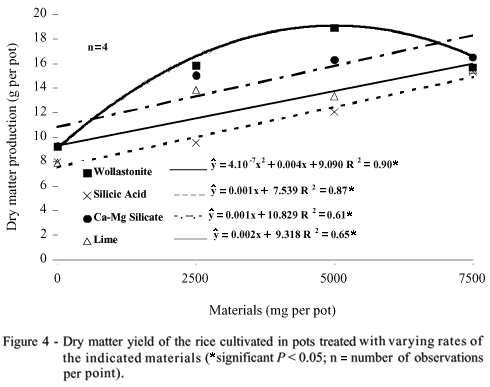The solubility and availability of silicon can be influenced by soil reaction. A pot experiment with a clayey textured Rhodic Acrustox was conducted under greenhouse conditions to evaluate the effect of soil reaction on silicon availability to rice plants. The experiment was set up in a completely randomized design, using a factorial scheme (4 x 4) with four materials (calcitic lime, calcium and magnesium silicate, pure silicic acid, and wollastonite), four rates (0, 2500, 5000 and 7500 mg per 5 kg-pot) and four replicates. After 60 days, dry matter yield and silicon absorption by the rice shoot plants, pH CaCl2, and soluble silicon (0.5 mol L-1 acetic acid and 0.01 mol L-1CaCl2) in the soil were evaluated. The materials increased soil pH as the applied rates increased, except silicic acid. Soluble silicon extracted by 0.5 mol L-1 acetic acid also increased with applied rates. For calcium chloride, soluble silicon increased in the soil only with wollastonite and calcium and magnesium silicate, agreeing with its total content. Silicon absorption by the above-ground part of the rice plants was linearly correlated with rates of wollastonite, followed by calcium and magnesium silicate, silicic acid and calcitic lime. Soil pH increase with lime was not sufficient to provide silicon to the rice. The 0.01 mol L-1 CaCl2 soluble silicon had the best correlation with silicon absorption by plants. More studies are necessary under field conditions and other soils to corroborate the presented results.
Oriza sativa; soil; calcitic lime; silicate







